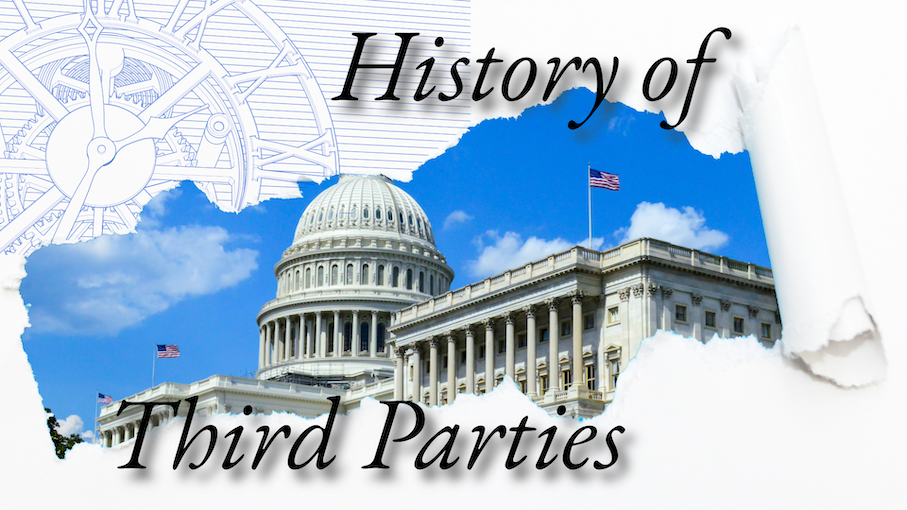By Koa Davidson
The 2024 election has been described as unique for a myriad of reasons. Among these being the popularity of independent candidate Robert F. Kennedy Jr., this is significant in that it is rare for any candidate to gain popularity outside of the two-party bubble, let alone an independent. Though his viability to win the presidency is extremely small, he has still achieved success by being on the ballot in 46 of the 50 states. With that being said Kennedy is far from the first to step up to the plate and attempt to break the Two-Party system. Ever since the days of the Federalists fighting the Anti-Federalists, there has been a demand for a new option.
The Anti-Masonic party was founded during the election of 1828. The nation had recently exited what is known as “The Era of Good Feelings” a time from 1815-1825 when the United States was effectively a One-Party state under the Democratic-Republicans. Despite all candidates being part of the same party, the 1824 elections featured four candidates on the ballot: John Quincy Adams, Henry Clay, William Crawford and Andrew Jackson. Jackson had secured the highest number of electoral votes but failed to secure the majority of votes which is what is needed to win the presidency according to the Electoral College. Because of this, the presidency was to be determined by congress, who ended up choosing John Qunicy Adams. The disgruntled Jackson took issue with this and sought to form a party based on the principle that a democratically elected president held more legitimacy than one determined by the electoral college; The Democratic Party.
Jackson became a divisive figure throughout the election of 1828 for breaking with the Democratic-Republicans and taking a solidly Southern identity which defined his politics. Among these controversies was Jackson’s affiliation with the Freemasons. The Freemasons are a movement comprising several Christian civic organizations which began as an outgrowth of the Rosicrucian movement of the 17th century. They have a very closed-off nature, intentionally revealing very little about their internal operations. Due to this they have, for centuries, been the subject of many conspiracy theories. Freemasonry was particularly unpopular in the region of upstate New York, as it was a hotbed of radical Protestantism during the Second Great Awakening, many thought that the secretive religious nature of the masons was anti-Christian and that Jackson winning the presidency was a front for the Masons to secretly take control the US government.
As this theory spread throughout the Northeastern United States a former Mason named William Morgan who spoke out against the organization mysteriously vanished, this led newspaper publisher Solomon Southwick to announce that there was a need to form an official political bulwark against the masons, thus he formed the Anti-Masonic party in Albany, New York. Though they ultimately ended up helping Jackson by splitting the vote between the Whigs they still had a significant impact in our election process as they were the first party to hold a national convention to announce their presidential ticket and formalize their election campaign, something which both parties practice to this day.
The most successful third party in a U.S. election was the Progressive Party. The party was founded by Theordore Roosevelt in 1912, by this point he had already served two terms as a Republican but decided to run for an unprecedented third as a Republican after growing dissatisfied with the direction of the party under President Taft, however he lost the nomination which compelled him to form a new party. Upon losing the nomination for Republican nominee, Roosevelt remarked that he felt as “strong as a bull-moose” and decided to make the animal the new symbol for his party, the mascot became so iconic that the name Bull-Moose Party was often used in place of its official name, The Progressive Party.
The party platform of the Progressives was radical for its time; campaigning on policies such as: mandatory disclosures of campaign donors for politicians, a tax on inheritances, mandatory worker’s compensation, an eight-hour workday, an early form of Social Security, and a nationalized healthcare system. Roosevelt ran an aggressive campaign against Taft. Famously an attempt on Roosevelt’s life was made during this election. Before a scheduled rally in Milwaukee, John Schrank shot Roosevelt in the chest, however it was stopped by the script to the speech which he was to give. Instead of going to the hospital, he chose to carry on to the rally and deliver the speech. This story made Roosevelt a martyr for his cause and the party surged in popularity.
When election day came, The Progressives took second place— the only third party to ever do so— with 81 electoral votes. Ultimately, the Progressives and Republicans had split the non-Democrat vote; allowing Democratic nominee Woodrow Wilson to win the presidency, something which most historians agree would not have happened had the Progressives never formed. The Progressives had seen success in several state elections; electing congressmen in New York, California, Illinois, Pennsylvania, Michigan, Louisiana, and Washington, but all only served one term. Roosevelt retired from politics after the election, though he was unwillingly named the Progressive nominee in 1916.
The party was built around Roosevelt and without him at the helm the party rapidly declined, as most supporters returned to supporting the Republicans. The party was officially dissolved in 1920, though its legacy persists in laying the groundwork for future progressive politics in America, many policies proposed by the party were later used by Franklin D. Roosevelt as part of his New Deal and the notion of a national healthcare service is still being campaigned for by Progressive politicians like Bernie Sanders and Alexandria Ocasio-Cortez to this day.
Today, there exists many third parties. Among the biggest are the Libertarian and Green Party. The Libertarian Party was founded in 1971 in Colorado. The party was formed during a time of growing interest in Austrian economics and interest in the work of novelist Ayn caused by the New Right movment in the Republican Party. They remained obscure, even by third party standards, until the early 2010s with the presidential campaign of Ron Paul, although he was seeking the Republican nomination, his ideas still drew from many put forward by Libertarians and led to interest forming in the ideology.
The party is based on the principle that a government that governs best is one that governs least. In general, they support laissez-faire economics, meaning they want minimal taxation and minimal regulation in the economy. They are hardline anti-interventionists; believing that the purpose of the military should be to directly defend the nation, not get involved with others. Socially, they advocate against most forms of societal regulation such as banning abortion; upholding civil liberties above all. While some may call their social views left-wing, this would be a tad inaccurate as numerous Libertarian politicians believe in a states’ rights to enact social legislation. An example of this would be in 2021 when the Libertarian Party of New Hampshire, one of the most influential chapters in the country, called for the repeal of the Civil Rights Act of 1964, labeling it an overstep of government power. This statement garnered heavy backlash from both Democrats, Republicans, and even some Libertarians.
The Libertarian Party holds no offices on a state or national level; however, they hold 177 offices in local and county positions, mainly in Kentucky and Pennsylvania.
The Green Party is the second largest Third Party in the United States. Having also been founded in the 1970s, but this time by those who were concerned with the environment following the rise of the New Left in America. They are focused on environmental protection above all else, hence their name being Green. They also promote other progressive left policies, such as universal healthcare, anti-interventionism, and federal legalization of abortion.
They rose to prominence as third party in 2000 with the campaign of Ralph Nader. They did not gain any electoral votes, but the media exposure did help them gain support from the broader American Progressive Left. Throughout the 2000s and 2010s, they gained popularity as documentaries like An Inconvenient Truth brought climate change to the national conscience. However, membership has waned in recent years as Democrats have put combating climate change as part of their core values with policy proposals like the Green New Deal. Originally, Cornel West was viewed as the likely Green Party nominee but chose to run as an independent instead. As of writing, the Green Party is currently without a candidate for the 2024 presidential election.
Like the Libertarians, they hold neither state nor national offices but have 131 local and county positions primarily in the New England region and California. Third parties can influence close elections by taking votes which otherwise would have gone to another candidate giving another candidate the edge in votes, leading to their victory. Along with this, third parties are also important in that they give a platform for issues which may be ignored by both parties; for example, the Libertarian and Green parties were both early advocates for marijuana legalization an issue which both Democrats and Republicans have neglected in their campaigns. Even though the possibility of having a third party in power nationally is slim, they still serve a significant role in our history and function of our republic.
Graphic created by Ryder Nivarra





